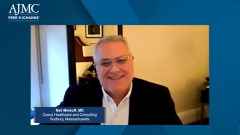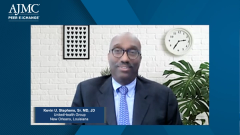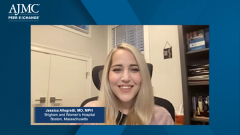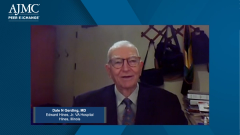
Defining Traditional Risk Factors for Developing C. Diff Infection
Opening their discussion, panelists elucidate patient factors that may impact risk of developing clostridium difficile infection.
Episodes in this series

Transcript:
Neil Minkoff, MD: Hello, and welcome to the AJMC® Peer Exchange titled “Therapies and Preventive Strategies for Recurrent Clostridium Difficile Infections.” I’m Dr Neil Minkoff, the chief medical officer of Coeus Healthcare and Consulting. Joining me in this discussion are my colleagues Dr Dale Gerding, a research physician at the Edward Hines Jr. Veterans Affairs Hospital [in Hines, Illinois]; Dr Jessica Allegretti, an associate director of the Crohn’s and Colitis Center at Brigham and Women’s Hospital [in Boston, Massachusetts]; Dr Kevin Stephens, the regional chief medical officer for employer and individual accounts at UnitedHealth Group; and Dr Karina Abdallah, the director of clinical pharmacy at Blue Cross Blue Shield of Michigan.
Our panel of experts will discuss payer and clinical considerations for recurrent C difficile [Clostridium difficile] infection, including the current guidelines and recommended treatment pathways, unmet needs, and emerging therapies. With that, I’ll begin. Before we get to recurrence, the first thing we need to do is make sure everybody understands the traditional risk factors for developing C difficile infection, whether it’s things like exposure, age, comorbid conditions, and even medications people are taking. Dr Gerding, could you please lead that discussion?
Dale N. Gerding, MD: Sure, I’ll give it a shot. We used to describe C difficile as a 2-hit disease. The reason it’s a 2-hit disease is because if you’re exposed to Clostridium difficile spores, which we probably all are on an almost-daily basis, we usually don’t get sick. The reason is because we have a good microbiota that protects us from becoming colonized with C difficile. A 2-hit disease means you need something to disrupt your microbiota first, and that’s normally antibiotics. They’re the most common factor that leads to susceptibility to C difficile infection. The second hit is exposure to spores.
Both of these hits are unfortunately more common in health care environments. The obvious 1 is that antibiotic prescriptions come via the health care system. That’s how we get exposed to antibiotics. But we also get exposed to spores of C difficile more frequently in the health care environment. Ironically, you’d think that would be the place that would be the safest, but in fact, it’s 1 of the more contaminated environments. Those are the 2 hits.
A third hit is whether patients have immunity to the toxins of C difficile. If they lack immunity, as many people do when they’re older, that means they’re susceptible to getting diarrhea as a result of antibiotic exposure, C difficile exposure, and a lack of antibodies against the C difficile toxins. Increasing age is obviously a risk factor, immunosuppression of the patient is a risk factor, and proton pump inhibitors [PPIs], which interestingly are also antibiotics because they’re used to treat another infection, Helicobacter pylori, are also risk factors in these patients. It’s an interesting disease. Usually we start with an infection and then treat with an antibiotic. In this case, we start with an antibiotic and then get an infection, but then we treat with another antibiotic.
Neil Minkoff, MD: Does anybody else want to weigh in on the things they worry about when they’re looking for risk factors for C difficile?
Jessica Allegretti, MD, MPH: Yes. I’m a gastroenterologist, so our patients with inflammatory bowel disease are at significantly increased risk. These patients are atypical in that they tend to be younger and are community dwellers. They’re not hospital dwellers. I’m always on high alert, especially when a patient with IBD [inflammatory bowel disease] is presenting with new or worsening symptoms. It’s important to ask about any antibiotic exposure, as Dr Gerding just mentioned, because it’s not just clindamycin. There’s no such thing as a good antibiotic with regard to development of C difficile. It’s important to ask those questions about antibiotic exposures, any immunosuppression, and PPI use as well. These are the things that we know to be risk factors for not only primary but also recurrent C difficile, so these are the questions I’m asking my patients when I’m assessing them.
Neil Minkoff, MD: Let me follow up with you on that. What’s the role of gut dysbiosis in C difficile or at least recurrent C difficile? How do you look for that? How do you tie that into exposure?
Jessica Allegretti, MD, MPH: As we just heard, this is a disease that is most typically kicked off by the use of antibiotics, and then we treat it with more antibiotics. You can imagine that the gut microbiome is playing a substantial role. We have developed, over evolution, this colonization resistance in the gut, meaning we have bacteria in our gut that essentially protect us against C difficile germination and release of that toxin. Let’s say you take clindamycin for a tooth abscess. You ablate those critical members of your gut microbiome that are upholding that colonization resistance, and you’re now at risk. We know that you’ve set up this pro–C difficile milieu in your gut, and that leads to subsequent recurrences.
What is it about the gut microbiome? It’s probably not just which bugs are present but also which functions they’re providing you. My laboratory is very interested in the role of bile salt metabolism and how that plays a role in C difficile recurrence. It’s not just which bugs are present but also those that are able to convert primary to secondary bile acids, which we know are protective in the colon. You’ve knocked out those critical members and set up this very pro–C difficile milieu, and you just keep treating with more antibiotics. You no longer have the tools to be able to overcome this infection. You’ve essentially ablated your gut microbiome. This is why the role of novel microbiome therapeutics is so exciting, because you’re essentially giving the patient back those tools to reestablish colonization resistance.
Transcript edited for clarity.
Newsletter
Stay ahead of policy, cost, and value—subscribe to AJMC for expert insights at the intersection of clinical care and health economics.



































































